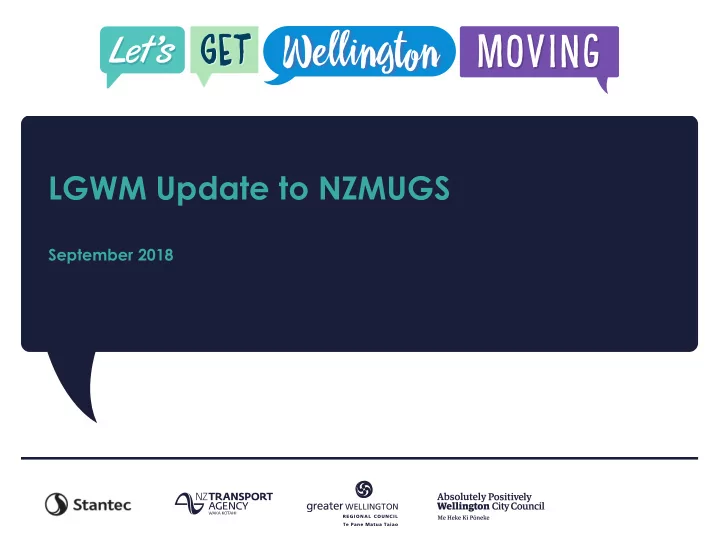

LGWM Update to NZMUGS September 2018
Project objectives • enhances the liveability of the central city • provides more efficient and reliable access for users • reduces reliance on private vehicle travel • improves safety for all users • adaptable to disruptions and future uncertainty • “move more people with fewer vehicles” • Improved travel choices
Dealing with Uncertainty Outcome will vary depending on population growth, economic conditions, changing modal preferences, technology, etc… What is the vision? What is the pathway to achieve this vision? What are the dependencies / assumptions? Do we have flexibility to change tack if required? Outcome-based approach, model parameters adjusted to represent likely futures / visions, rather than ‘predict -and- provide’ approach.
Recent trends – no increase in cars entering CBD between 7am and 9am… Net growth 7am to 9am attributed to PT (and active modes) Auckland and Wellington very similar.
… but looking across wider peak, volumes relatively unchanged but timing has changed • People leave earlier to avoid congestion… • Decreased volumes between 7am and 9am, as earlier onset of congestion reduces effective capacity at key bottlenecks • Little change in overall 5am to 9am volumes
Modelling assumptions - baseline Continuation of recent trends is a plausible future that we should plan for… … but future is uncertain, so shouldn’t just have one scenario. Two Baseline scenarios for LGWM: • Trend: follows recent observed modal shares, rapid PT growth and flattening of car trips to the CBD and VKTs, particularly in AM peak • Balanced: car and PT trips to CBD grow at about same rate Model parameters modified to achieve outcomes, rather than slavishly following forecasts (which themselves are based on forecasts based on forecasts…)
Validation of changes - Back-casting of rail growth • 2013 to 2018 – 20% growth in peak period rail patronage • Previous forecast versions of WTSM did not capture this growth
Modelling Assumptions – PT Improvements Improvements in PT infrastructure represented through perception factors on PT times: Improved punctuality, better PT stop facilities → Waiting time factors Improved vehicle quality and reliability (especially LRT/BRT) → In-vehicle time factors High quality interchanges and dedicated hubs for transfers → Boarding penalties New mode + New City / Country = Uncertainty
Land use response to LGWM interventions • Land use is often a common input to Do Min and Option • But significant infrastructure can potentially affect the distribution and rate of growth • MR Cagney commissioned to understand the potential impact of LGWM programme on future distribution of population and employment within region • Emerging area for transport appraisal – if land use changes were easy to model, would do so on more regular basis • Three approaches to triangulate most likely outcome • Supply side • Demand side – accessibility/density • Demand side – spatial general equilibrium
Supply side analysis Additional PT improvements Existing bus • Constraints by mid / late 2020, Do Min unable to support growth • 25% of growth to CBD via PT would not be able to be served in 2046 • Analysis focussed on bus network but equally applies to rail • Potential economic costs and lost opportunities
Composite scenario – change in population • Increased residential population along the affected corridor, driven by improved accessibility • Slight decrease in CBD and rest of region • Growth differential changes – rest of region still growing but more slowly
Composite scenario – change in employment • City centre employment increases due to removal of CBD Do Min capacity constraint and improved accessibility – greater labour pool within 30 min of employment • Increases economic productivity by moderately increasing the share of regional employment located in the city centre • Further scope for re-distribution of future growth to Te Aro area of CBD
Economic analysis – Transport models Based on EEM procedures and consumer surplus method. For PT, 2 different approaches: EEM Approach: based on unweighted model output. → Consistency with EEM and standard evaluation in New Zealand Alternative Approach: uses perceived (weighted) travel times from the model. → Reflects trip making decisions as estimated in the model → Includes non-standard travel times benefits. Potentially more contentious, but EEM does allow for including infrastructure and vehicles non-time benefits (see A18.7 for EEM buffs!)
Car accessibility to CBD, AM Peak, 2036 Do Minimum Option 1 Option 2
PT accessibility to CBD, AM Peak, 2036 Do Minimum Option 1
Lessons Learned • Early stage of study, (relatively) coarse model returns sufficiently detailed results and allows for fast turn-around. • Pragmatic approach to account for known limitations of the models, using model as tool to support / inform rather than make decisions • Important to highlight limitations with analysis, be up front about assumptions, identify where further work required at next stage, otherwise people will start quoting numbers out of context..… • Manage expectations – people want something definitive from model results, therefore interpretation and context is vital
Recommend
More recommend